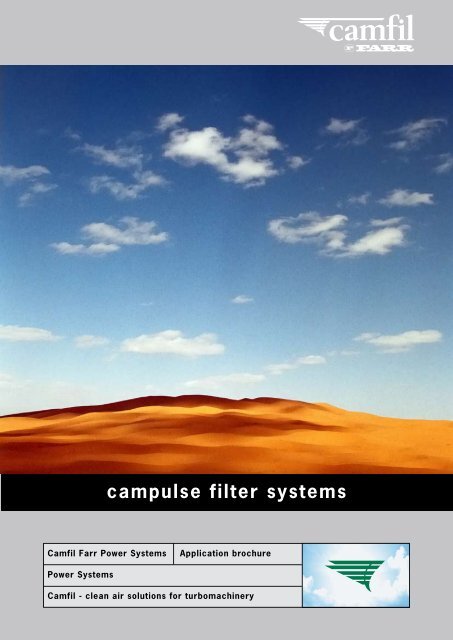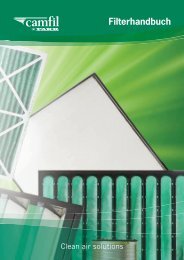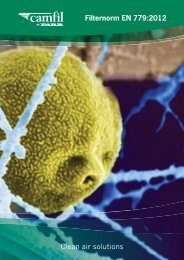campulse filter systems - Camfil Farr
campulse filter systems - Camfil Farr
campulse filter systems - Camfil Farr
You also want an ePaper? Increase the reach of your titles
YUMPU automatically turns print PDFs into web optimized ePapers that Google loves.
<strong>campulse</strong> <strong>filter</strong> <strong>systems</strong><br />
<strong>Camfil</strong> <strong>Farr</strong> Power Systems Application brochure<br />
Power Systems<br />
<strong>Camfil</strong> - clean air solutions for turbomachinery
CamPulse EF Filter Systems – Self Cleaning<br />
for really tough environments<br />
CamPulse air <strong>filter</strong> <strong>systems</strong> are designed<br />
to protect rotating machinery operating in<br />
high dust load environments where conventional<br />
static <strong>systems</strong> suffer from frequent<br />
service intervals resulting in reduced availability,<br />
frequent shutdowns and high maintenance<br />
cost.<br />
The CamPulse system is selfcleaning<br />
during operation allowing full continuous<br />
operation at low stable pressure drop even<br />
in extremely dusty environments as they<br />
may occur in some parts of the world.<br />
The cleaning system is activated as a<br />
function of the dust load and avoids sudden<br />
increases in pressure drop. This eliminates<br />
CamPulse Systems offer<br />
■ High efficiency, optimum protection<br />
■ Stable, low operating pressure drop<br />
■ Continuous, maintenance-free operation<br />
■ High reliability and availability<br />
■ Simple installation and operation<br />
the need for un<strong>filter</strong>ed air bypass doors as<br />
are common for static <strong>filter</strong> <strong>systems</strong> and<br />
increases the degree of protection of the<br />
machine.<br />
How it works<br />
CamPulse is a single stage automatic selfcleaning<br />
barrier <strong>filter</strong> using multiple cylindrical<br />
and/or conical <strong>filter</strong> elements. The<br />
<strong>filter</strong> elements are arranged horizontally in<br />
rows and sealed positively against the<br />
clean air chamber.<br />
In the normal <strong>filter</strong>ing mode, dustladen<br />
ambient air is drawn into the upper<br />
part of the housing and flows through the<br />
<strong>filter</strong> elements, through the tube sheet<br />
C a m f i l F a r r<br />
and into the clean air chamber. Dust particles<br />
are trapped on the outside surface of the<br />
<strong>filter</strong> media. As the surface becomes loaded<br />
with contaminants, air flow is restricted<br />
increasing pressure drop. When a preset<br />
level is reached, the self cleaning cycle is<br />
automatically initiated.<br />
The cleaning takes place during normal<br />
operation by injecting compressed<br />
air into a number of <strong>filter</strong> elements in<br />
reverse-flow direction without interrupting<br />
the normal air flow through the system.<br />
The dust pulsed off the <strong>filter</strong> elements can<br />
drop freely and re-entrainment of fine dust<br />
particles is greatly reduced by the positive<br />
downdraft.<br />
CamPulse’s self-cleaning cycle is<br />
automatically activated on demand by a
pressure sensor or a timer. A combination<br />
of both methods may be used. When the<br />
cleaning cycle is activated, pulses of<br />
compressed air are discharged in the reverse<br />
direction of normal flow through the<br />
injector nozzles into the <strong>filter</strong> elements.<br />
The injected compressed air is further<br />
augmented by air from the clean-air chamber<br />
creating a combined air mass with the<br />
necessary pressure to properly dislodge dust<br />
particles trapped on the outside surface<br />
of the <strong>filter</strong> element. The compressed air<br />
used during the cleaning cycle is supplied<br />
through blowpipes arranged downstream<br />
of each row of <strong>filter</strong>s.<br />
Each blowpipe has air nozzles corresponding<br />
with each <strong>filter</strong> element and<br />
cleans two ore more element a time.<br />
The reverse high pressure pulses are<br />
generated by a quick acting diaphragm<br />
valve mounted ahead of each blowpipe.<br />
The valve is actuated by a solenoid valve,<br />
which in turn is sequentially controlled by<br />
a solid state electronic timer.<br />
Air<br />
entrance<br />
Air entrance (optional)<br />
The sequencer regulates frequency interval<br />
and pulse duration. Each blowpipe is attached<br />
to a common manifold which contains the<br />
compressed air used to pulse the <strong>filter</strong> elements.<br />
Normally between 5% and not more<br />
than 15% of the <strong>systems</strong> <strong>filter</strong>s are cleaned<br />
simultaneously. This ensures a constant<br />
and uninterrupted flow of air.<br />
The self-cleaning sequence is maintained<br />
until the unit returns to the desired<br />
normal operating pressure level and the<br />
self cleaning cycle stops. When reactivation<br />
is necessary, the cycle starts where it left<br />
off. The cyclical action insures that all <strong>filter</strong><br />
elements are cleaned on a regular basis<br />
and ensures an uninterrupted supply of<br />
clean air.<br />
The evacuation of the dust pulsed-off<br />
is further assisted by one or more scavenge<br />
air fans in the lower part of the <strong>filter</strong> housing.<br />
The fans increase the downdraft of<br />
dust from the pulsed elements and reduce<br />
the re-entrainment of dust to adjacent elements<br />
to a minimum.<br />
Dust removal<br />
Principle of operation<br />
Clean<br />
air outlet<br />
C l e a n a i r s o l u t i o n s f o r t u r b o m a c h i n e r y<br />
CamPulse Filter System for GE Frame 6 unit in Spain.<br />
Filter module open for inspection.<br />
CamPulse Filter Systems are<br />
designed for use in high dust<br />
load environments. We offer<br />
three other <strong>filter</strong> <strong>systems</strong> which<br />
are designed for specific<br />
environments:<br />
■ Barrier Filter Systems<br />
■ Offshore Filter Systems<br />
■ Marine Filter Systems
Europe:<br />
Borås, Sweden tel: +46 33 17 85 00<br />
Bremen, Germany tel: +49 421 47886 0<br />
Kreuzau, Germany tel: +49 2421 22 49 80<br />
Brussels, Belgium tel: +32 2 68 80 520<br />
Filtration characteristics<br />
The heart of the <strong>filter</strong> system is the highly efficient CamPulse element. The single<br />
stage cylindrical barrier type <strong>filter</strong> is specially engineered for selfcleaning<br />
applications. It employs a unique surface acting cellulose and/or synthetic<br />
fibre base media that effectively removes contaminants. In fact, its remarkable<br />
<strong>filter</strong>ing capability measures up to a 99,95% efficiency rating during an average<br />
service life.<br />
Consistent operating pressure levels<br />
The CamPulse system consistently maintains average operating pressure levels<br />
without sacrificing filtration efficiency. This is accomplished by the unique media<br />
used, and the regular automatic self-cleaning of the <strong>filter</strong> elements. Accumulated<br />
dust is regularly removed from the surface of the elements, keeping pressure<br />
drop variations at a minimum.<br />
Actual pressure drop variations over time are impossible to predict. However,<br />
a typical design range of 500 to 1000 Pa provides optimum efficiency and the<br />
most economical application.<br />
Cross section of CamPulse <strong>filter</strong>module with optional chiller coil arrangement.<br />
www.camfilfarr.com<br />
info.gt@camfilfarr.com<br />
<strong>Camfil</strong> <strong>Farr</strong> Power Systems<br />
Americas:<br />
Laval, Canada tel: +1 450 629 30 30<br />
tel: +1 800 976 93 82<br />
Middle East:<br />
Dubai tel: +971 4 887 1796<br />
Asia:<br />
India tel: +91 124 40 82 406<br />
Japan tel: +81 6361 38 36 (Tominaga & CO Ltd)




